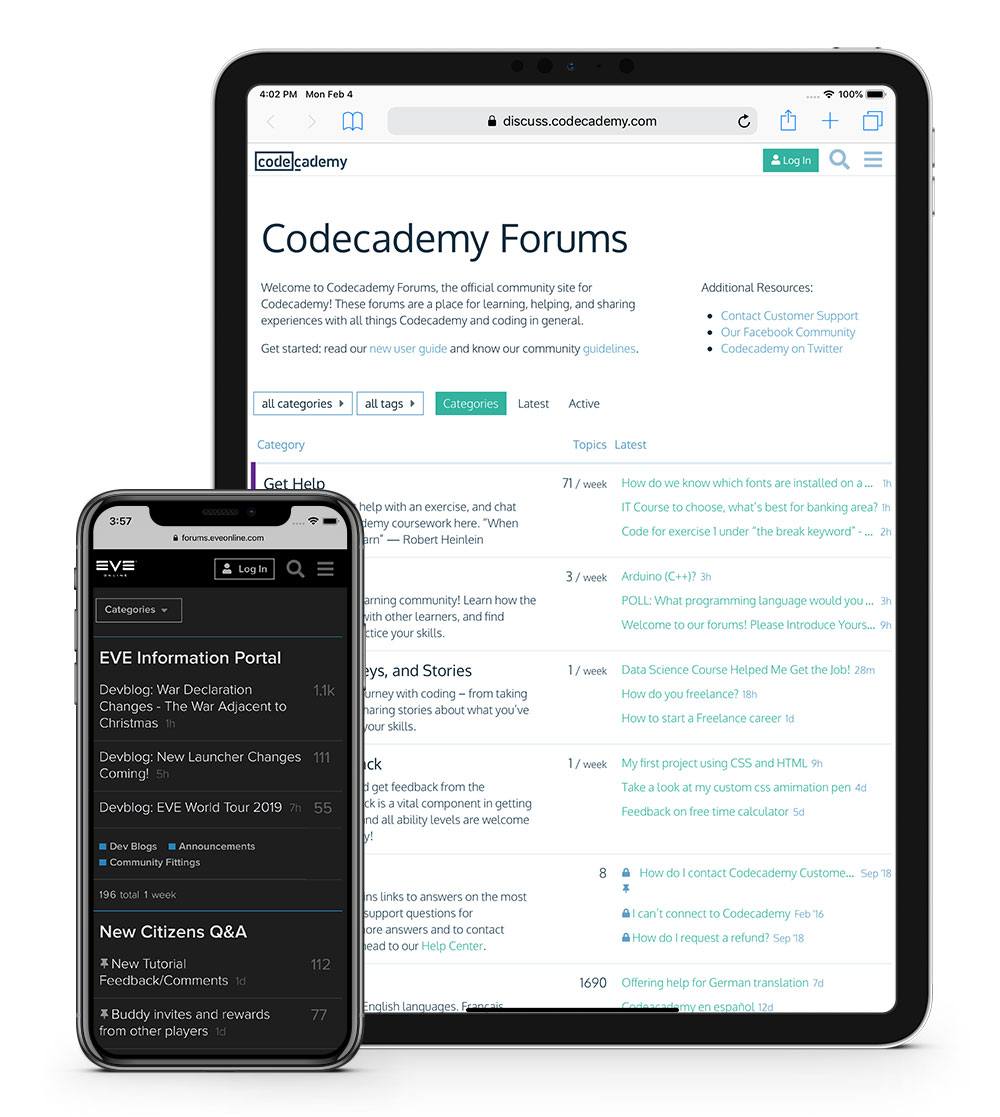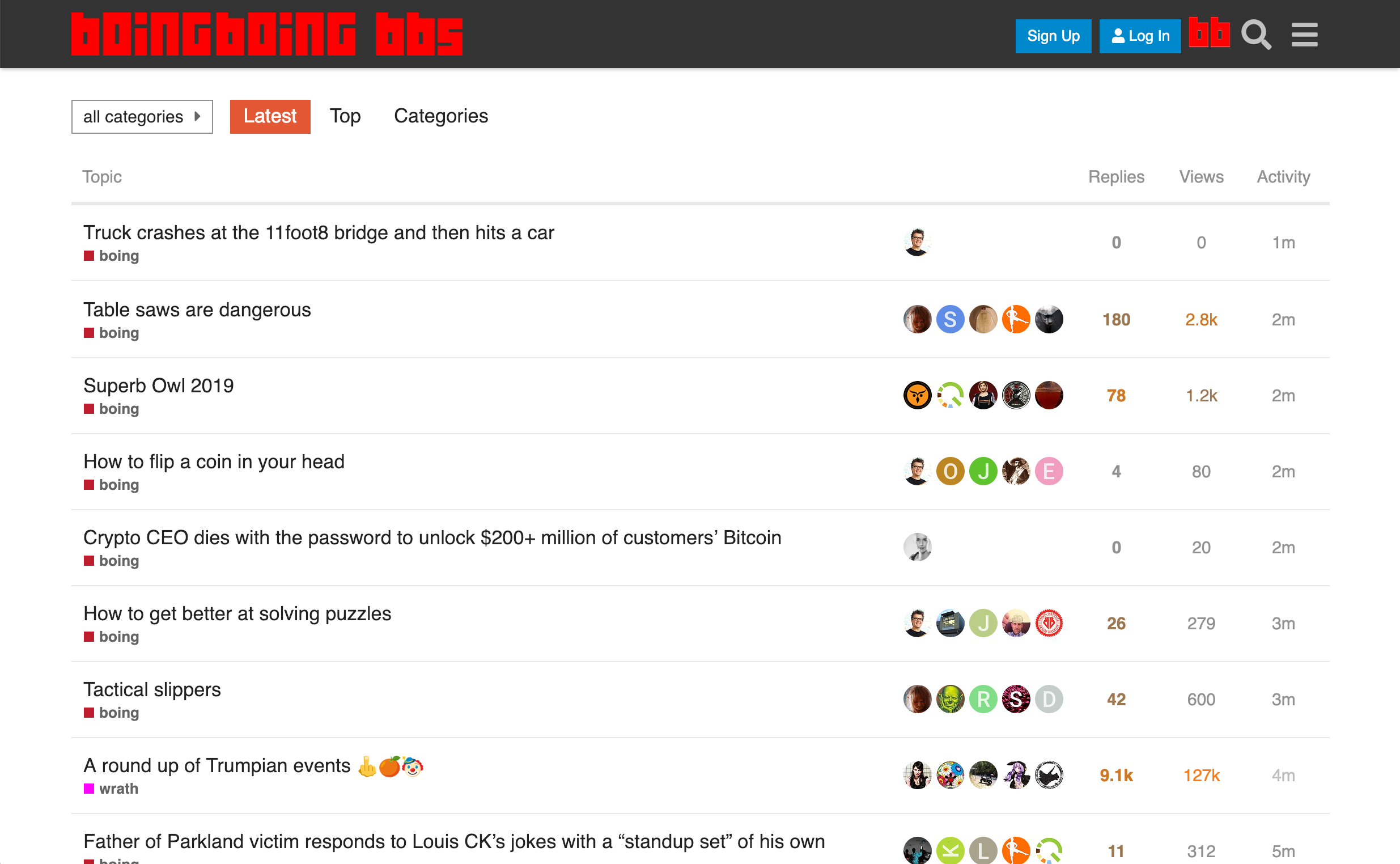PresenceChannel aims to be a generic system for allow the server, and end-users, to track the number and identity of users performing a specific task on the site. For example, it might be used to track who is currently 'replying' to a specific topic, editing a specific wiki post, etc.
A few key pieces of information about the system:
- PresenceChannels are identified by a name of the format `/prefix/blah`, where `prefix` has been configured by some core/plugin implementation, and `blah` can be any string the implementation wants to use.
- Presence is a boolean thing - each user is either present, or not present. If a user has multiple clients 'present' in a channel, they will be deduplicated so that the user is only counted once
- Developers can configure the existence and configuration of channels 'just in time' using a callback. The result of this is cached for 2 minutes.
- Configuration of a channel can specify permissions in a similar way to MessageBus (public boolean, a list of allowed_user_ids, and a list of allowed_group_ids). A channel can also be placed in 'count_only' mode, where the identity of present users is not revealed to end-users.
- The backend implementation uses redis lua scripts, and is designed to scale well. In the future, hard limits may be introduced on the maximum number of users that can be present in a channel.
- Clients can enter/leave at will. If a client has not marked itself 'present' in the last 60 seconds, they will automatically 'leave' the channel. The JS implementation takes care of this regular check-in.
- On the client-side, PresenceChannel instances can be fetched from the `presence` ember service. Each PresenceChannel can be used entered/left/subscribed/unsubscribed, and the service will automatically deduplicate information before interacting with the server.
- When a client joins a PresenceChannel, the JS implementation will automatically make a GET request for the current channel state. To avoid this, the channel state can be serialized into one of your existing endpoints, and then passed to the `subscribe` method on the channel.
- The PresenceChannel JS object is an ember object. The `users` and `count` property can be used directly in ember templates, and in computed properties.
- It is important to make sure that you `unsubscribe()` and `leave()` any PresenceChannel objects after use
An example implementation may look something like this. On the server:
```ruby
register_presence_channel_prefix("site") do |channel|
next nil unless channel == "/site/online"
PresenceChannel::Config.new(public: true)
end
```
And on the client, a component could be implemented like this:
```javascript
import Component from "@ember/component";
import { inject as service } from "@ember/service";
export default Component.extend({
presence: service(),
init() {
this._super(...arguments);
this.set("presenceChannel", this.presence.getChannel("/site/online"));
},
didInsertElement() {
this.presenceChannel.enter();
this.presenceChannel.subscribe();
},
willDestroyElement() {
this.presenceChannel.leave();
this.presenceChannel.unsubscribe();
},
});
```
With this template:
```handlebars
Online: {{presenceChannel.count}}
<ul>
{{#each presenceChannel.users as |user|}}
<li>{{avatar user imageSize="tiny"}} {{user.username}}</li>
{{/each}}
</ul>
```
|
||
|---|---|---|
| .devcontainer | ||
| .github | ||
| .vscode-sample | ||
| app | ||
| bin | ||
| config | ||
| db | ||
| docs | ||
| images | ||
| lib | ||
| log | ||
| plugins | ||
| public | ||
| script | ||
| spec | ||
| test | ||
| vendor | ||
| .editorconfig | ||
| .eslintignore | ||
| .eslintrc | ||
| .git-blame-ignore-revs | ||
| .gitattributes | ||
| .gitignore | ||
| .licensed.yml | ||
| .npmrc | ||
| .prettierignore | ||
| .prettierrc | ||
| .rspec | ||
| .rspec_parallel | ||
| .rubocop.yml | ||
| .ruby-gemset.sample | ||
| .ruby-version.sample | ||
| .template-lintrc.js | ||
| Brewfile | ||
| CONTRIBUTING.md | ||
| COPYRIGHT.md | ||
| Gemfile | ||
| Gemfile.lock | ||
| LICENSE.txt | ||
| README.md | ||
| Rakefile | ||
| adminjs | ||
| config.ru | ||
| d | ||
| discourse.sublime-project | ||
| jsapp | ||
| lefthook.yml | ||
| package.json | ||
| translator.yml | ||
| yarn.lock | ||
README.md

Discourse is the 100% open source discussion platform built for the next decade of the Internet. Use it as a:
- mailing list
- discussion forum
- long-form chat room
To learn more about the philosophy and goals of the project, visit discourse.org.
Screenshots

Browse lots more notable Discourse instances.
Development
To get your environment setup, follow the community setup guide for your operating system.
- If you're on macOS, try the macOS development guide.
- If you're on Ubuntu, try the Ubuntu development guide.
- If you're on Windows, try the Windows 10 development guide.
If you're familiar with how Rails works and are comfortable setting up your own environment, you can also try out the Discourse Advanced Developer Guide, which is aimed primarily at Ubuntu and macOS environments.
Before you get started, ensure you have the following minimum versions: Ruby 2.7+, PostgreSQL 13+, Redis 6.0+. If you're having trouble, please see our TROUBLESHOOTING GUIDE first!
Setting up Discourse
If you want to set up a Discourse forum for production use, see our Discourse Install Guide.
If you're looking for business class hosting, see discourse.org/buy.
If you're looking for our remote work solution, see teams.discourse.com.
Requirements
Discourse is built for the next 10 years of the Internet, so our requirements are high.
Discourse supports the latest, stable releases of all major browsers and platforms:
| Browsers | Tablets | Phones |
|---|---|---|
| Apple Safari | iPadOS | iOS |
| Google Chrome | Android | Android |
| Microsoft Edge | ||
| Mozilla Firefox |
Built With
- Ruby on Rails — Our back end API is a Rails app. It responds to requests RESTfully in JSON.
- Ember.js — Our front end is an Ember.js app that communicates with the Rails API.
- PostgreSQL — Our main data store is in Postgres.
- Redis — We use Redis as a cache and for transient data.
- BrowserStack — We use BrowserStack to test on real devices and browsers.
Plus lots of Ruby Gems, a complete list of which is at /main/Gemfile.
Contributing
Discourse is 100% free and open source. We encourage and support an active, healthy community that accepts contributions from the public – including you!
Before contributing to Discourse:
- Please read the complete mission statements on discourse.org. Yes we actually believe this stuff; you should too.
- Read and sign the Electronic Discourse Forums Contribution License Agreement.
- Dig into CONTRIBUTING.MD, which covers submitting bugs, requesting new features, preparing your code for a pull request, etc.
- Always strive to collaborate with mutual respect.
- Not sure what to work on? We've got some ideas.
We look forward to seeing your pull requests!
Security
We take security very seriously at Discourse; all our code is 100% open source and peer reviewed. Please read our security guide for an overview of security measures in Discourse, or if you wish to report a security issue.
The Discourse Team
The original Discourse code contributors can be found in AUTHORS.MD. For a complete list of the many individuals that contributed to the design and implementation of Discourse, please refer to the official Discourse blog and GitHub's list of contributors.
Copyright / License
Copyright 2014 - 2021 Civilized Discourse Construction Kit, Inc.
Licensed under the GNU General Public License Version 2.0 (or later); you may not use this work except in compliance with the License. You may obtain a copy of the License in the LICENSE file, or at:
https://www.gnu.org/licenses/old-licenses/gpl-2.0.txt
Unless required by applicable law or agreed to in writing, software distributed under the License is distributed on an "AS IS" BASIS, WITHOUT WARRANTIES OR CONDITIONS OF ANY KIND, either express or implied. See the License for the specific language governing permissions and limitations under the License.
Discourse logo and “Discourse Forum” ®, Civilized Discourse Construction Kit, Inc.
Dedication
Discourse is built with love, Internet style.



